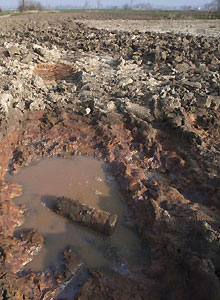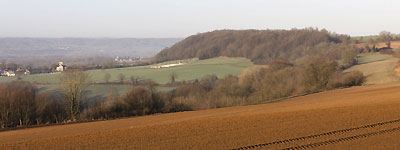|
SILENT LANDSCAPE
THE BATTLEFIELDS OF THE WESTERN FRONT - 100 YEARS ON
by The Editor
|
 Guards’ Grave at Villers-Cotterêts, where 4th Guards Brigade fought a fierce rearguard action on 1st September 1914. 98 Guardsmen were buried here by the local French population, in the centre of the forest that has changed
Guards’ Grave at Villers-Cotterêts, where 4th Guards Brigade fought a fierce rearguard action on 1st September 1914. 98 Guardsmen were buried here by the local French population, in the centre of the forest that has changed
little since the battle was fought over a century ago |
The landscape over which The Great War was fought fell silent at 11 o'clock on 11th November 1918, although the battlefields themselves were to remain a mire as well as a powder keg for many years. Clearing the ground of the dreadful detritus of war and giving a decent grave to the many thousands of soldiers whose bodies had yet to be recovered was a long and at times hazardous task that continues 100 years on. Farmers who lived and worked inside the Zone Rouge waited years before they were allowed to return to their farms and their livelihood, but these places could never be entirely safe. A century on, nasty metal and often explosive reminders of the war rise to the surface: horrible gas canisters, dud shells that failed to do their business when they should have done, and the ridiculously shaped 2-inch medium mortars (the ‘toffee apples’) that tumbled in the air and landed the wrong way up. Tragically, there are still fatalities as a result of this ‘iron harvest’.
 A muddy field revealing another
A muddy field revealing another
example of the ‘iron harvest’ |
Many thousands of soldiers still lie undiscovered on the battlefields and occasionally the earth gives up their remains so that a soldier can be given a decent burial and the military funeral he deserves. Jack Kipling, the18 year old son of Rudyard, was killed at the Battle of Loos in 1915 while serving with the Irish Guards, and only recently has the grave of an unnamed Irish Guards officer been identified as his. His fellow guardsmen knew he was dead, but without a positive identity of his body, his parents roamed the hospitals behind the lines looking for their son. Rudyard never recovered from his loss, nor his sense of guilt for his son’s death. Thankfully, however, his atonement led to two memorable achievements. The first was his History of the Irish Guards in the Great War, a very special and beautifully written two volume account. The second was the simple and poignant lines used on the graves and memorials that are such a feature of the landscape in Flanders and France: ‘Their name liveth for evermore’; and ‘Their glory shall not be blotted out’. Little is known of Kipling’s religious views and it may well be that he was a ‘non-believer’ like his father. What is certain is that he respected the reality that many of those who died during the war were not members of the established Church of England. Indeed, some of these soldiers, as the architect Edwin Lutyens identified, had no faith at all. The nearest that Kipling came was with ‘A soldier of the Great War known unto God’, the same words that, for many years, appeared on the gravestone of his unidentified son, Jack.
The memorials and cemeteries along the Western Front, many of which were designed by Lutyens and other leading architects of the day, have become the most noticeable and enduring legacy of the war. In some respects they are the markers by which we can interpret the ebb and flow of the battles fought over such a narrow ribbon of mostly rural landscape that stretches from the unforgiving and flat low country of Flanders to the equally challenging mountains of the Vosges, close to the Swiss border. For a few short weeks in the Autumn of 1914, the great European armies tried to fight the kind of war for which they had trained and equipped themselves. But soon the combined effects of physical exhaustion and the power of modern weapons led to a static war fought from trenches separated by a ‘no man’s land’ where movement was all but impossible.
 Vendresse Cemetery, where 14 Coldstream Guardsmen and 2 Scots Guardsmen, all killed in September and October 1914, are buried. Close to here, above the River Aisne, trench warfare began in The Great War Vendresse Cemetery, where 14 Coldstream Guardsmen and 2 Scots Guardsmen, all killed in September and October 1914, are buried. Close to here, above the River Aisne, trench warfare began in The Great War |
The intensity and frequency with which the front-line trenches and this same ground that lay between them was fought over has left deep scars on the landscape that will remain for ever more. The trenches themselves were mostly filled in after the war, but some remain while others have been recently excavated and are now preserved. The huge landmines that were laid underground at the end of long tunnels below enemy trenches created monstrous craters and huge unnatural contours that have now become an indelible feature of the landscape. The many woods and forests that were gradually destroyed until only shredded tree stumps remained, have now re-grown, serving to protect the uneven and pot-marked ground created a century ago.
The extent to which the landscape was changed by The Great War is a unique phenomenon because the nature of the fighting and the destructive power of industrialised warfare bore extremely heavily on these small battlefields. Time and again, ground was fought over until, eventually in 1918, some sense of mobility was restored. As in 1914, the fighting was still fierce and costly in human terms, but the vista changed almost daily as armies advanced and retreated. Try and find traces of these battles and the search becomes more difficult, just as it does when following the movements of armies in the Second World War. Cities, towns and villages have generally been rebuilt, and all traces of war have been removed, save for the memorials constructed later. The story in the countryside is different; the evidence is there, and always will be. Like almost no other war, the silent landscape bears witness to the terrible events of 100 years ago.
Silent Landscape. Battlefields of the Western Front 1914-1918. 100 Years On. Written by Simon Doughty. Photography by James Kerr. Published by Helion & Co, June 2016.
www.silentlandscape.com
 The battlefield of Loos, a stark place where the only features are the slag heaps from the coal mines below and the cemeteries that were built after the battle The battlefield of Loos, a stark place where the only features are the slag heaps from the coal mines below and the cemeteries that were built after the battle |
|
|




